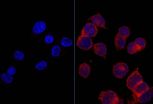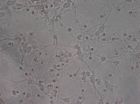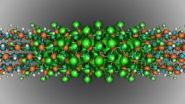(Press-News.org) For almost a hundred years ago is known that cancer cells feel a special appetite for a type of sugar called glucose. The tumor uses this molecule is like the gasoline which depends a sports car to burn faster and grows and multiplies rapidly. It is a little cash process from the energy point of view but allows a superaccelerated cancer cell division. It is what is known as the Warburg effect, which was described in 1927.
Until now little was known about how healthy cells that have a balanced energy consumption depend on this "fast food" calorie in the tumor cell. Today, an article published in Nature Communications led by Manel Esteller, Director of Epigenetics and Cancer Biology, Bellvitge Biomedical Research Institute (IDIBELL), ICREA researcher and Professor of Genetics at the University of Barcelona, provides an important clue to understand this process. Research shows that in one in four human tumors, there is an excess of glucose receptors in the external face of the cell membrane and this protein acts as a magnet attracting all the glucose from the bloodstream.
"We were looking for genes that did not work in tumor cells and we found an altered one, but unaware what his function. we discovered that it was responsible for removing excess of glucose receptors" explained Esteller . "So what happens is that the gene that should degrade glucose receptor is inactivated in sound condition and quit, this tumor has an overactivation of this receptor that captures all the glucose molecules around it and used to obtain quick energy to proliferate. It is a cancer that has become addicted to this caloric molecule. "
"The interesting part is to study whether future treatments that fight the tumor and also quit the energy source of the tumor cells, the tumor dies because it cannot easily be adapted to use other substrates for energy to survive," concludes Esteller
INFORMATION:
Article reference
Lopez-Serra P, Marcilla M, Villanueva A, Ramos-Fernandez A, Palau A, Leal L, Wahi JE, Setien-Baranda F, Szczesna K, Moutinho C, Martinez-Cardus A, Heyn H, Sandoval J, Puertas S, Vidal A, Sanjuan X, Martinez-Balibrea E, Viñals F, Perales JC, Bramsem JB, Ørntoft TF, Andersen CL, Tabernero J, McDermott U, Boxer MB, Vander Heiden MG, Albar JP, Esteller M. A DERL3 Associated Defect in the Degradation of SLC2A1 Mediates the Warburg Effect. Nature Communications, April 3rd, 2014.
Discovery of a mechanism that makes tumor cells sugar addicted
2014-04-04
ELSE PRESS RELEASES FROM THIS DATE:
Vascular changes caused by deep brain stimulation using brain MRI
2014-04-04
Deep brain stimulation has been widely used to treat patients with movement disorders and increasing attention has been paid to its use in the treatment of neurological and psychiatric disorders. However, the influence of subthalamic nucleus or pallidal deep brain stimulation on cerebral vasculature is poorly understood. Even though the metabolic changes caused by deep brain stimulation are being studied using positron emission tomography, the structural changes in cerebral areas like the intracerebral vasculature have not yet been evaluated. Dr. Byeong Sam Choi and colleagues ...
Clinical value of ginsenoside Rb1 against neuronal damage following cerebral ischemia
2014-04-04
Activated microglia-mediated inflammation promotes neuronal damage under cerebral hypoxic-ischemic conditions, so it is likely that inhibiting hypoxia-induced activation of microglia will alleviate neuronal damage. To test this hypothesis, Dr. Lining Ke and co-workers from Southern Medical University and Fujian Medical University in China co-cultured ginsenoside Rb1, an active component of ginseng, and cortical neurons. Their findings indicate that ginsenoside Rb1 attenuates damage to cerebral cortex neurons by downregulation of nitric oxide, superoxide, and tumor necrosis ...
Depression increases heart failure risk by 40 percent
2014-04-04
Stavanger, Norway – 4 April 2014: Moderate to severe depression increases the risk of heart failure by 40%, a study of nearly 63 000 Norwegians has shown. The findings were presented for the first time today at EuroHeartCare 2014.
EuroHeartCare is the official annual meeting of the Council on Cardiovascular Nursing and Allied Professions (CCNAP) of the European Society of Cardiology (ESC). This year's meeting is organised jointly with the Norwegian Society of Cardiovascular Nurses and is held 4-5 April in Stavanger, Norway.
Ms Lise Tuset Gustad, first author of the ...
Tracking sperm whales' ecology through stomach contents
2014-04-04
AMHERST, Mass. – In the largest regional study of its type to date, marine ecologist Michelle Staudinger and colleagues offer better understanding of the feeding ecologies of two very rare sperm whale species in waters off the southeast U.S. coast, adding baseline data they say are important as climate change, fishing and pollution alters the animals' environment and food sources.
"Understanding what resources support populations of these incredibly rare animals is important to conservation," Staudinger, adjunct assistant professor in environmental conservation at the ...
To bridge LEDs' green gap, scientists think small... really small
2014-04-04
Nanostructures half the breadth of a DNA strand could improve the efficiency of light emitting diodes (LEDs), especially in the "green gap," a portion of the spectrum where LED efficiency plunges, simulations at the U.S. Department of Energy's National Energy Research Scientific Computing Center (NERSC) have shown.
Using NERSC's Cray XC30 supercomputer "Edison," University of Michigan researchers Dylan Bayerl and Emmanouil Kioupakis found that the semiconductor indium nitride (InN), which typically emits infrared light, will emit green light if reduced to 1 nanometer-wide ...
Disease-free survival estimates for ovarian cancer improve over time
2014-04-04
SAN DIEGO, April 4, 2014 – The probability of staying disease-free improves dramatically for ovarian cancer patients who already have been disease-free for a period of time, and time elapsed since remission should be taken into account when making follow-up care decisions, according to a study led by researchers at the University of Pittsburgh Cancer Institute (UPCI), a partner with UPMC CancerCenter. The findings will be presented Wednesday at the American Association for Cancer Research (AACR) Annual Meeting 2014.
A patient's prognosis traditionally is determined when ...
A new species of horseshoe worm discovered in Japan after a 62 year gap
2014-04-04
The horseshoe worm is a worm-like marine invertebrate inhabiting both hard and soft substrates such as rock, bivalve shells, and sandy bottom. The name "horseshoe" refers to the U-shaped crown of tentacles which is called "lophophore." Horseshoe worms comprise a small phylum Phoronida, which contains only ten species decorating the bottom of the oceans.
The new species Phoronis emigi, the eleventh member of the group described in the open access journal ZooKeys, comes after a long 62 year gap of new discoveries in the phylum. It is unique in the number and arrangement ...
Recurrent head and neck tumors have gene mutations that could be vulnerable to cancer drug
2014-04-04
SAN DIEGO, April 4, 2014 – An examination of the genetic landscape of head and neck cancers indicates that while metastatic and primary tumor cells share similar mutations, recurrent disease is associated with gene alterations that could be exquisitely sensitive to an existing cancer drug. Researchers from the University of Pittsburgh Cancer Institute (UPCI) and Yale University School of Medicine will share their findings during a mini-symposium Sunday at the American Association for Cancer Research Annual Meeting 2014.
About 50 percent of patients diagnosed with head ...
Common breast cancer subtype may benefit from personalized treatment approach
2014-04-04
SAN DIEGO, April 4, 2014 – The second-most common type of breast cancer is a very different disease than the most common and appears to be a good candidate for a personalized approach to treatment, according to a multidisciplinary team led by scientists at the University of Pittsburgh Cancer Institute (UPCI), a partner with UPMC CancerCenter.
Invasive lobular carcinoma, characterized by a unique growth pattern in breast tissue that fails to form a lump, has distinct genetic markers which indicate drug therapies may provide benefits beyond those typically prescribed for ...
Plant-derived anti-cancer compounds explained at national conference
2014-04-04
SAN DIEGO, April 4, 2014 – Compounds derived from plant-based sources — including garlic, broccoli and medicine plants — confer protective effects against breast cancer, explain researchers at the University of Pittsburgh Cancer Institute (UPCI), partner with the UPMC CancerCenter.
In multiple presentations Sunday at the American Association for Cancer Research (AACR) Annual Meeting 2014, UPCI scientists will update the cancer research community on their National Cancer Institute (NCI)-funded findings, including new discoveries about the mechanisms by which the plant-derived ...



